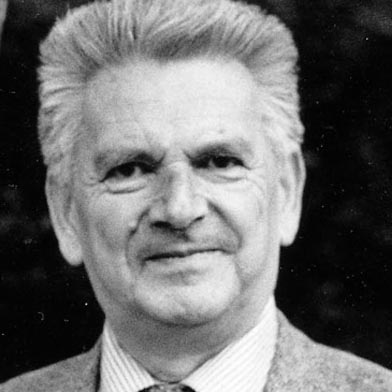1923-2023, Centenaire de René Thom
Centre de conférences Marilyn et James Simons
Le Bois-Marie
À l'occasion du centenaire de la naissance de René Thom, l’IHES organise trois jours de conférence les 20, 21 et 22 septembre 2023.
Conférenciers invités :
- Norbert A’Campo, Univ. De Bâle
- Daniel Bennequin, Institut Mathématique de Jussieu (IMJ-PRG)
- Alain Chenciner, IMCCE/Observatoire de Paris
- Antoine Danchin, Institut Pasteur
- Ivar Ekeland, Université Paris-Dauphine
- Sara Franceschelli, ENS Lyon
- Emmanuel Giroux, CNRS et ENS
- Mikhail Gromov, IHES
- Krzysztof Kurdyka, Université Savoie Mont Blanc
- Cherif Matta, Mount Saint Vincent University, Halifax, Canada
- Jean Petitot, EHESS
- Oscar Randal-Williams, Université de Cambridge
- Ana Rechtman, Université Grenoble-Alpes
- Dennis Sullivan, City University of New York, Graduate Center
- Bernard Teissier, IMJ-PRG
- Wolfgang Wildgen, Université de Brême
Comité scientifique : Marie-Claude Arnaud, IMJ-PRG, Marc Chaperon, IMJ-PRG, coordinateur, Antoine Danchin, Institut Pasteur, Yakov Eliashberg, Stanford University, Maxim Kontsevich, IHES, Cédric Villani, Université Lyon I & IHES
Comité d'organisation : Jean-Pierre Bourguignon, IHES
René Thom (1923-2002)
Professeur permanent à l'IHES de 1963 à 1990
René Tho m a couvert un champ scientifique immense : d'abord en ouvrant des champs nouveaux en topologie, cette branche des mathématiques qui s'intéresse aux formes à déformation près, et dans l'étude de la dynamique. Il a ensuite créé une « mathématique de la morphogenèse », proposant des modèles pour la biologie et aussi pour les sciences humaines.
m a couvert un champ scientifique immense : d'abord en ouvrant des champs nouveaux en topologie, cette branche des mathématiques qui s'intéresse aux formes à déformation près, et dans l'étude de la dynamique. Il a ensuite créé une « mathématique de la morphogenèse », proposant des modèles pour la biologie et aussi pour les sciences humaines.
Ces propositions, souvent regroupées sous le nom de « théorie des catastrophes », ont quelque fois été controversées. René Thom a consacré la suite de sa vie scientifique à l’étude de la biologie théorique et surtout à la philosophie aristotélicienne.
Aakash Gopinath
Ahmed Abbes
alberic de gayardon
Amir Mostaed
Andrzej Zuk
Anne Petitot
Anne Vaugon
Antoni Rangachev
Aurelien SAGNIER
Bernard Teissier
Brian Hepler
Bruno Duchesne
Bruno VALLETTE
Camilo Gomez Araya
Catriona Byrne
Charles-Michel Marle
Cherif Matta
Claude VITERBO
Clément Mouhot
Coda Stefano
Cyril PORÉE
Damien LARIVIÈRE
Dario Prandi
Dirk Siersma
Drimik Roy Chowdhury
Edmund Heng
Emmanuel FERRAID
Florian Ces
François Laudenbach
François LOESER
Frédéric Barbaresco
Gabriella Clemente
Giorgi Khimshiashvili
Grégoire Sergeant-Perthuis
Guglielmo Nocera
Himal Rathnakumara
Ibrahim Trifa
Ilia Itenberg
Jean Petitot
Jean-Claude Belfiore
Jean-Eric AUBERT
Jean-Michel Bismut
Jean-Michel Kantor
Jean-Patrick Lebacque
Jean-Pierre Marco
Jerome Bolte
Jianqiao Shang
Joël MERKER
Julien Randon-Furling
Kiese Mboka
Laurent Niederman
Lukas Juozulynas
Marc Chardin
marc serrero
Marcus Nicolas
Megan Khoshyaran
Micheline VIGUE
Mohamed Alaoui
Mustapha Hamad
Mélanie Bertelson
Nadya Morozova
Nicolas Bitar
Nicolas Guès
Olivier Peltre
Olukayode Adebimpe
Pacôme Van Overschelde
Paula TSATSANIS
Peter TSATSANIS
Pierre PANSU
Pierre Schapira
Qixiang Wang
rachid bebbouchi
Ricardo Menares
Richard Kruel
sabri ghozali
sabri ghozali
Samir Bouslamti
Sandra Hayes
Sandra Hayes
Sara Franceschelli
Sergei Kuksin
Sergey Finashin
Shrawan Kumar
Shuddhodan Kadattur Vasudevan
simon barazer
Simon Vialaret
Smail Chemikh
Sylvain Crovisier
Szilard Szabo
Thibault DAMOUR
Valentin Poenaru
Viatcheslav Kharlamov
Vincent Ezratti
Vincent Humilière
Yuanyang Jiang
Yuhao Xue
Yuxiao Xie
Yves Coudene
Ángel David RIOS ORTIZ
